Answer to Question 1
The parasympathetic branch of the autonomic system is generally associated with the state of relaxation, and after a stressful encounter its activation serves to damp down the fight-or-flight response. As noted previously, the neurons of this system have their effect on their visceral targets through the use of the neurotransmitter acetylcholine. Most tissues of the viscera are innervated by both branches of the system. There are some exceptions; for example, the blood vessels and the adrenal medulla receive only sympathetic branch neurons.
Though it is common to think that only the sympathetic branch excites the organs (e.g., heart rate increase), that is a misconception. For example, it is the parasympathetic branch and not the sympathetic branch that excites the gastrointestinal system. The reason that some components of the viscera are excited by the sympathetic branch and others by the parasympathetic branch has to do with how the body's systems deal with threats to its survival. During normal resting non-stress periods it is more adaptive for the body to ingest food when needed, digest it, and store its energy. Without doing this, the body will not survive. However, during acute stress periods when there is imminent threat to survival, it is more adaptive to avoid ingesting food, stop digesting food previously ingested, and start mobilizing and expending energy. That is, to activate the fight-or-flight response.
Answer to Question 2
The peripheral nervous system is comprised of both the somatic nervous system and the autonomic nervous system. The somatic nervous system innervates the skeletal muscles (striated muscles), the skin, and the sense organs. This bidirectional neural network transmits information from the brain to the periphery (the outer regions) and vice versa. The neural pathways that send signals from the brain to the periphery are called efferent and those that send signals from the periphery to the brain are called afferent.
In the somatic nervous system efferent pathways carry messages from the motor areas of the neocortex to the striated (red colored) muscles to facilitate voluntary motor movement. Afferent pathways carry sensory information from the sense receptors to the sensory areas of the neocortex through the sensory projection systems. During the fight-or-flight response the brain sends messages through the efferent neurons to the striated muscles to tense in preparation for physical action.







